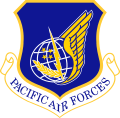| 25th Fighter Squadron | |
|---|---|
 A-10 Thunderbolt II 80-213 taking off from Osan AB | |
| Active | 1941–1945; 1946–1960; 1965–1990; 1993–present |
| Country | |
| Branch | |
| Role | Fighter |
| Part of | Pacific Air Forces |
| Garrison/HQ | Osan Air Base |
| Nickname | Assam Draggins [1] |
| Motto | "PILSUNG!" (Korean: Certain Victory) [1] |
| Colors | Green[ citation needed ] |
| Mascot | Elvis[ citation needed ] |
| Engagements | China-Burma-India Theater Korean War Vietnam War [2] |
| Decorations | Distinguished Unit Citation Presidential Unit Citation Air Force Outstanding Unit Award with Combat "V" Device Air Force Outstanding Unit Award Republic of Korea Presidential Unit Citation Vietnam Gallantry Cross with Palm [2] |
| Insignia | |
| 25th Fighter Squadron emblem (approved 22 May 1996) [2] |  |
| 25th Fighter Squadron emblem (approved 1 August 1947) [3] |  |
| 25th Fighter Squadron emblem (World War II) [4] [note 1] |  |
The 25th Fighter Squadron was part of the US Air Force's 51st Operations Group, 51st Fighter Wing, at Osan Air Base, South Korea. It operated the Fairchild Republic A-10 Thunderbolt II aircraft conducting close air support missions. It was inactivated in June 2025. [5]






